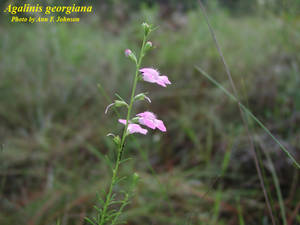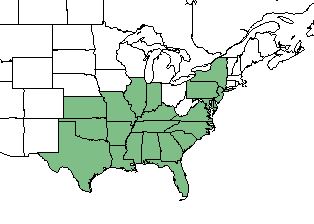Agalinis georgiana
| Agalinis georgiana | |
|---|---|

| |
| Photo by Ann Johnson | |
| Scientific classification | |
| Kingdom: | Plantae |
| Division: | Magnoliophyta - Flowering plants |
| Class: | Magnoliopsida - Dicots |
| Order: | Scrophulariales |
| Family: | Scrophulariaceae |
| Genus: | Agalinis |
| Species: | A. georgiana |
| Binomial name | |
| Agalinis georgiana (Elliott) Raf. | |

| |
| Natural range of Agalinis georgiana from USDA NRCS Plants Database. | |
Common name: Boynton's false foxglove, Georgia agalinis, Boynton's agalinis
Contents
Taxonomic Notes
Synonyms: Gerardia georgiana (C.L. Boynton) Pennell, Agalinis fasciculata (Elliott) Rafinesque. [1]
Description
Endemic to the southeastern U.S., A. georgiana is an annual forb that is a member of the Scrophulariaceae family. [2] Like all other members of the Agalinis genus, A. georgiana is a root parasite, which is a type of hemiparasite that penetrates roots of neighboring plants to transfer food and water from the host plant. However, they are semiparasitic since they still contain their own chlorophyll and can produce their own food.[3] A. georgiana is glabrous, with bright green herbage, and contains pale corollas that lack spots and lines within.[4]
Distribution
A. georgiana is distributed from south Georgia and Alabama down to the western panhandle of Florida.[1]
Ecology
Habitat
A. georgiana is observed in dry and well-drained upland longleaf pine savanna communities, and shady sandy loams of pine-oak woods.[5] In these communities, A. georgiana can be quite frequent in the understory composition.[6] It can also be found in bogs.[1]
Agalinis georgiana is an indicator species for the Upper Panhandle Savannas community type as described in Carr et al. (2010).[7]
Associated Species: Pinus palustris, Quercus falcata, Diospyros virginiana, Ilex glabra, Agalinis obtusifolia, and Ctenium aromaticum.[5]
Phenology
Agalinis georgiana has been observed to flower in the months of September and November.[5][8]
Fire ecology
A. georgiana has been recorded in longleaf pine savannas that are burned annually.[5]
Herbivory and toxicology
Members of the Agalinis genus, including this one, host larvae of the common buckeye butterfly (Junonia coenia) in Florida.[9]
Conservation, cultivation, and restoration
Cultural use
Photo gallery
References and notes
- ↑ 1.0 1.1 1.2 Weakley, A.S. 2020. Flora of the Southeastern United States. Edition of 20 October 2020. University of North Carolina at Chapel Hill, Chapel Hill, North Carolina.
- ↑ USDA Plants Database URL: https://plants.usda.gov/core/profile?symbol=ANGE
- ↑ Musselman, L. J. and W. F. Mann, Jr (1978). Root parasites of southern forests. , USDA Forest Service, Southern For. Exp. Station, New Orleans, LA. Gen. Tech. Rpt. SO-20. : 76.
- ↑ Pennell, F. W. (1929). "Agalinis and allies in North America: II." Proceedings of the Academy of Natural Sciences of Philadelphia 81: 111-249.
- ↑ 5.0 5.1 5.2 5.3 Florida State University Robert K. Godfrey Herbarium database. URL: http://herbarium.bio.fsu.edu. Last accessed: February 2019. Collectors: Loran C. Anderson, W. Wilson Baker, John Hays, Mike Jenkins, Robin Kennedy, R. Komarek, and Alfred Schotz. States and counties: Florida: Jackson, Liberty, Okaloosa, and Santa Rosa. Georgia: Thomas.
- ↑ Carr, S. C., et al. (2010). "A Vegetation Classification of Fire-Dependent Pinelands of Florida." Castanea 75(2): 153-189.
- ↑ Carr, S.C., K.M. Robertson, and R.K. Peet. 2010. A vegetation classification of fire-dependent pinelands of Florida. Castanea 75:153-189.
- ↑ Nelson, G. PanFlora: Plant data for the eastern United States with emphasis on the Southeastern Coastal Plains, Florida, and the Florida Panhandle. www.gilnelson.com/PanFlora/ Accessed: 4 MAR 2019
- ↑ Observation by Roger Hammer in Silver Springs State Park, Marion County, FL. September 2016, posted to Florida Flora and Ecosystematics Facebook Group August 4, 2017.